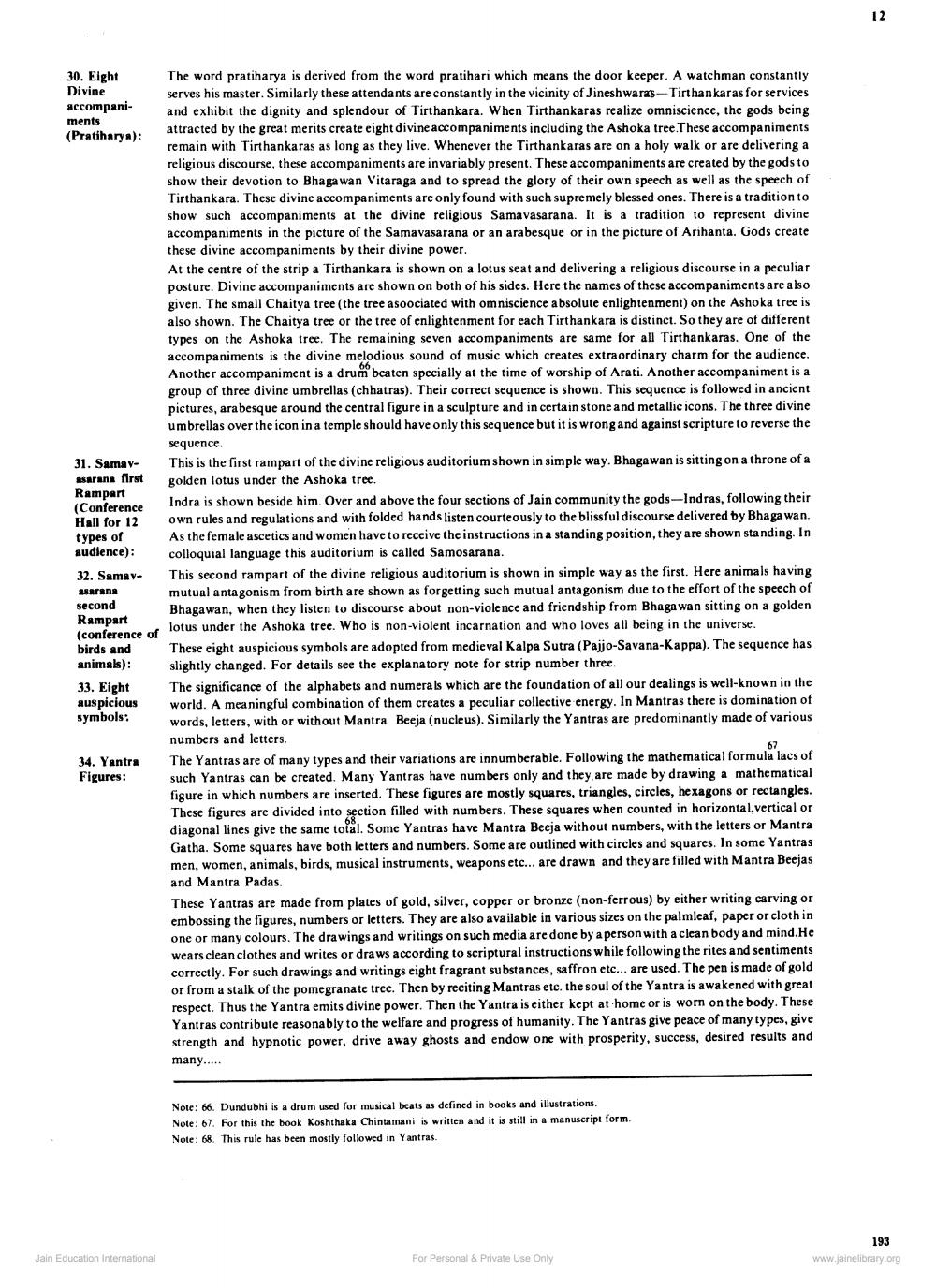________________
30. Eight Divine
accompani
ments
(Pratiharya):
34. Yantra Figures:
The word pratiharya is derived from the word pratihari which means the door keeper. A watchman constantly serves his master. Similarly these attendants are constantly in the vicinity of Jineshwaras-Tirthankaras for services and exhibit the dignity and splendour of Tirthankara. When Tirthankaras realize omniscience, the gods being attracted by the great merits create eight divine accompaniments including the Ashoka tree.These accompaniments remain with Tirthankaras as long as they live. Whenever the Tirthankaras are on a holy walk or are delivering a religious discourse, these accompaniments are invariably present. These accompaniments are created by the gods to show their devotion to Bhagawan Vitaraga and to spread the glory of their own speech as well as the speech of Tirthankara. These divine accompaniments are only found with such supremely blessed ones. There is a tradition to show such accompaniments at the divine religious Samavasarana. It is a tradition to represent divine accompaniments in the picture of the Samavasarana or an arabesque or in the picture of Arihanta. Gods create these divine accompaniments by their divine power.
Jain Education International
At the centre of the strip a Tirthankara is shown on a lotus seat and delivering a religious discourse in a peculiar posture. Divine accompaniments are shown on both of his sides. Here the names of these accompaniments are also given. The small Chaitya tree (the tree asoociated with omniscience absolute enlightenment) on the Ashoka tree is also shown. The Chaitya tree or the tree of enlightenment for each Tirthankara is distinct. So they are of different types on the Ashoka tree. The remaining seven accompaniments are same for all Tirthankaras. One of the accompaniments is the divine melodious sound of music which creates extraordinary charm for the audience. Another accompaniment is a drum beaten specially at the time of worship of Arati. Another accompaniment is a group of three divine umbrellas (chhatras). Their correct sequence is shown. This sequence is followed in ancient pictures, arabesque around the central figure in a sculpture and in certain stone and metallic icons. The three divine umbrellas over the icon in a temple should have only this sequence but it is wrong and against scripture to reverse the
66.
31. Samayasarana first Rampart (Conference Hall for 12 types of audience): 32. Samavasarana
This second rampart of the divine religious auditorium is shown in simple way as the first. Here animals having mutual antagonism from birth are shown as forgetting such mutual antagonism due to the effort of the speech of Bhagawan, when they listen to discourse about non-violence and friendship from Bhagawan sitting on a golden (conference of lotus under the Ashoka tree. Who is non-violent incarnation and who loves all being in the universe.
second
Rampart
These eight auspicious symbols are adopted from medieval Kalpa Sutra (Pajjo-Savana-Kappa). The sequence has slightly changed. For details see the explanatory note for strip number three.
birds and animals): 33. Eight auspicious symbols:
sequence.
This is the first rampart of the divine religious auditorium shown in simple way. Bhagawan is sitting on a throne of a golden lotus under the Ashoka tree.
Indra is shown beside him. Over and above the four sections of Jain community the gods-Indras, following their own rules and regulations and with folded hands listen courteously to the blissful discourse delivered by Bhagawan. As the female ascetics and women have to receive the instructions in a standing position, they are shown standing. In colloquial language this auditorium is called Samosarana.
The significance of the alphabets and numerals which are the foundation of all our dealings is well-known in the world. A meaningful combination of them creates a peculiar collective energy. In Mantras there is domination of words, letters, with or without Mantra Beeja (nucleus). Similarly the Yantras are predominantly made of various numbers and letters.
67
The Yantras are of many types and their variations are innumberable. Following the mathematical formula lacs of such Yantras can be created. Many Yantras have numbers only and they are made by drawing a mathematical figure in which numbers are inserted. These figures are mostly squares, triangles, circles, hexagons or rectangles. These figures are divided into section filled with numbers. These squares when counted in horizontal, vertical or diagonal lines give the same total. Some Yantras have Mantra Beeja without numbers, with the letters or Mantra Gatha. Some squares have both letters and numbers. Some are outlined with circles and squares. In some Yantras men, women, animals, birds, musical instruments, weapons etc... are drawn and they are filled with Mantra Beejas and Mantra Padas.
These Yantras are made from plates of gold, silver, copper or bronze (non-ferrous) by either writing carving or embossing the figures, numbers or letters. They are also available in various sizes on the palmleaf, paper or cloth in one or many colours. The drawings and writings on such media are done by a person with a clean body and mind.He wears clean clothes and writes or draws according to scriptural instructions while following the rites and sentiments correctly. For such drawings and writings eight fragrant substances, saffron etc... are used. The pen is made of gold or from a stalk of the pomegranate tree. Then by reciting Mantras etc. the soul of the Yantra is awakened with great respect. Thus the Yantra emits divine power. Then the Yantra is either kept at home or is worn on the body. These Yantras contribute reasonably to the welfare and progress of humanity. The Yantras give peace of many types, give strength and hypnotic power, drive away ghosts and endow one with prosperity, success, desired results and many.....
Note: 66. Dundubhi is a drum used for musical beats as defined in books and illustrations.
Note: 67. For this the book Koshthaka Chintamani is written and it is still in a manuscript form. Note: 68. This rule has been mostly followed in Yantras.
For Personal & Private Use Only
121
193
www.jainelibrary.org




